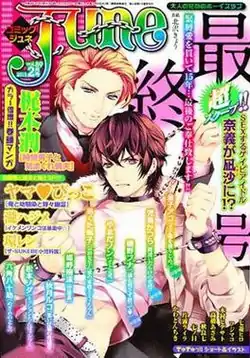June (magazine)
June (Japanese: ジュネ) [d͡ʑu͍ ne] was a yaoi magazine published by Magazine Magazine between 1978 and 2012. The magazine was a toko zasshi, a magazine which mainly publishes unsolicited manuscripts with a small honorarium.[2] In June, stories were not required to include a "love scene".[2]
 Cover of the last February 2013 issue of June | |
| Editor | Toshihiko Sagawa |
|---|---|
| Categories | fiction, essays, yaoi, shōjo, josei |
| Frequency | Bimonthly[1] |
| Circulation | 80,000-100,000 (1995)[1] |
| Publisher | Magazine Magazine |
| Year founded | 1978 |
| Final issue Number | December 28, 2012 February 2013 |
| Country | Japan |
| Language | Japanese |
History
June was the earliest yaoi (BL) magazine, which began in 1978 as a response to the success of commercially published manga such as the works of female artists Keiko Takemiya, Moto Hagio and Yumiko Ōshima. Other factors that influenced the founding of June were the rising popularity of depictions of bishōnen in the dōjinshi market and ambiguous musicians such as David Bowie and Queen.[3] June was meant to have an underground, "cultish, guerilla-style" feeling – most of its manga artists were new talent. Frederik L. Schodt describes June as "a kind of 'readers' magazine, created by and for the readers."[1] Very early on, Keiko Takemiya became the editor of a section called "Manga School", which instructed readers and amateur manga authors.[4] June magazine ceased operations in 1979, but was relaunched in 1981. Azusa Nakajima ran a contest in the magazine for readers called "Shosetsu dojo" ("Novel School") which was an important platform for aspiring writers.[2]
June magazine was named after the French author Jean Genet, with "june" being a play on the Japanese pronunciation of his name. Digital Manga Publishing had an unrelated BL imprint which is also called June.[5] The magazine's name became an early name for what is now the BL genre,[6] as June published male/male tanbi 耽美 ("aesthetic") romances, stories written for and about the worship of beauty,[6] and romance between older men and beautiful youths[7] using particularly flowery language and unusual kanji.[6] Essays about the characteristics of the June genre were published with the manga in June. In 1982, Shōsetsu June ("Novel June"), a sister magazine to June began publication. Its content was text-only stories with male romance.[1]
In 1991, Sandra Buckley noted that June was increasing its coverage of gay culture in response to its gay readership, and she credits the magazine with "playing a role in the construction of a collective gay identity" in Japan.[8] As of the mid-1990s, Shōsetsu June outsold June.[1] In 1996, there were four June magazines - one called June, in a "large format" with many photos of youths, Roman June ("Romantic June") which contained a mix of stories and manga, intended for an older female reader, Shousetsu June, and the original manga magazine, retitled Comic June, for general fujoshi audiences.[1] Circulation of June was 40,000 in 1998.[2] As of 2002, June was still running, although the target audience's ages had widened and the style of stories had changed from being "soft love" to occasionally being more overtly "pornographic".[3][4]
On 6 April 2006, Koi June was launched, which published 3-4 issues per year[9] which ran for seven issues until 19 January 2009.[10] This magazine included manga, text-only stories and a DVD. A single-issue sister magazine, DVD June, was published on 9 February 2007. Both were subsequently merged using the latters name, with the first issue (DVD June Vol.8) published on 18 June 2009 and still running.[11]
Creators associated with June included Tomomi Kobayashi, Kaoru Kurimoto (both as an author and as a critic), Keiko Takemiya, Mizuki Kawashita and Akimi Yoshida. The last issue was published on 28 December 2012 (February 2013 issue).[12]
Titles
- Ai no Kusabi (Shousetsu June)
- Fujimi Orchestra
- Uozumikun[2]
- Sensitive Pornograph (Comic June Piace Series)
- Great Place High School
References
- Schodt, Frederik L. (1996) Dreamland Japan: Writings on Modern Manga pages 120-123
- Mizoguchi Akiko (2003). "Male-Male Romance by and for Women in Japan: A History and the Subgenres of Yaoi Fictions". U.S.-Japan Women’s Journal, 25: 49-75.
- Toku, Masami (6 June 2002) Interview with Mr. Sagawa
- http://www.csuchico.edu/~mtoku/vc/interviews_full/Interview%20w_Takemiya.html
- "Digital Manga Names New Yaoi Imprint: A Tribute to Jean Genet".
- "Definitions From Japan: BL, Yaoi, June". aestheticism.com. Archived from the original on 5 June 2009.
- Vincent, Keith (2007) "A Japanese Electra and Her Queer Progeny" Mechademia 2 pp.64-79
- Buckley, Sandra (1991) "'Penguin in Bondage': A Graphic Tale of Japanese Comic Books", p. 181. In Technoculture. C. Penley and A. Ross, eds. Minneapolis: University of Minnesota ISBN 0-8166-1932-8
- Demars, Anne (2008). "Les éditeurs de boys love". In Brient, Hervé (ed.). Homosexualité et manga : le yaoi. Manga: 10000 images (in French). Editions H. pp. 12–16. ISBN 978-2-9531781-0-4.
- "恋JUNE・他". June-net. Archived from the original on 15 February 2009. Retrieved 22 March 2017.
- "恋JUNE・他". June-net. Archived from the original on 17 March 2010. Retrieved 22 March 2017.
- June. 国立国会図書館サーチ [National Diet Library].